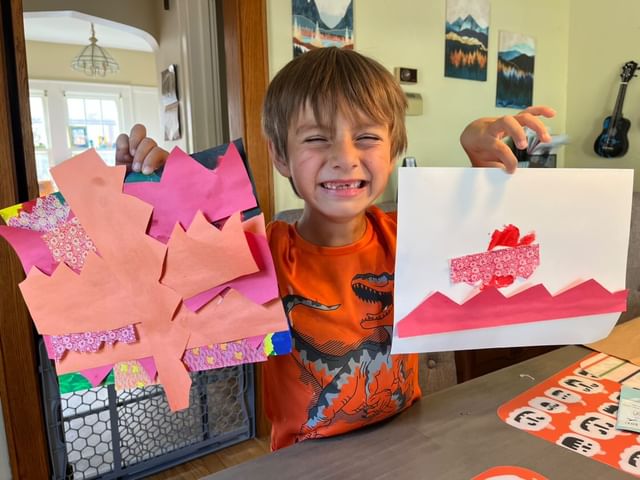11 Fun Ways to Include Art into Your Kindergarten Homeschool Classes


It’s never too early to start creating art with your little one.
For little hands exploring their place within the world, art offers a powerful tool for expression, learning, and joy. As a homeschooling parent, you have the unique opportunity to cultivate an enriching and engaging curriculum that prioritizes both academics and the arts.
There are so many creative ways to integrate art-based activities into your kindergartener’s homeschool work, fostering imagination, exploration, and a love for learning. Use our ideas for enriching your child’s homeschool art education.
Unlock the Magic of Art Journaling
Even our youngest artists have stories to tell, and an art journal becomes a safe space for them to express themselves visually. Provide your child with a dedicated notebook or sketchbook, paints, crayons, and other age-appropriate materials. Encourage them to draw a scene from their day, a favorite storybook character, or an emotion they’re feeling. Then discuss their creations together, helping them articulate their thoughts and feelings.
Step Through Time with Artist Studies
Art isn't just about making something visually pleasing. It's also about understanding the world around us. Integrate artist studies into your history, geography, or social studies curriculum. Explore the emotion of Frida Kahlo, the sweeping brush strokes of Vincent Van Gogh, the infiniteness of Yayoi Kusama, or the shining shapes of Gustav Klimt. As you study different cultures and historical periods, connect them to specific artists and their masterpieces to create a more holistic learning experience and sparks curiosity about the wider world.
The more you and your child integrate art into different school subjects, the more you’ll identify art all around you – like in the Sunday comics, murals in your city, even in the ironwork of manhole covers.
Try as Many Different Materials as Possible
Art helps develop your little one’s fine motor skills. Try out different materials, sizes of implements, and mediums. Go beyond traditional paints and crayons. Introduce your child to clay, playdough, chalk, fabric scraps, clippings from magazines, nature-found objects, and even recycled materials.
Experiment with different textures, tools, and techniques. Explore color mixing, collage making, and simple printmaking techniques. The focus is on the process of creating, not the finished product.
Find Art in Nature
The natural world is an incredible source of inspiration and learning. Take your art and science lessons outdoors! Collect colorful leaves, smooth stones, feathers, or interesting twigs and use them to create natural mandalas, decorate picture frames, or build miniature sculptures.
If you’d rather leave the outdoors outdoors, observe the movement of clouds, the patterns on butterfly wings, or the textures of different types of bark. Discuss the colors, shapes, and textures you see. Your child can take their art journal with them and sketch what they see.

Take Your Little Artist on a Fieldtrip
Museums offer invaluable opportunities for hands-on learning and engagement by exposing your child to diverse artistic styles, techniques, and cultures. Check your local art museum for programs and exhibits specifically for young audiences. Your local library may also have art education programs for homeschool kindergarteners.
When you visit, encourage your child to ask questions and share their observations. When you return home, they can create art inspired by what they learned and saw. When you introduce children to museums and cultural spaces at an early age, you lay the foundation for a lifelong appreciation for the arts.
Read Stories About Art
Combine the magic of reading with the joy of art. Choose books about artists’ stories. Then read together and have your child create illustrations, character portraits, or scenes from the story. Encourage them to interpret the story in their own unique way.

Combine Music and Art
Has your child ever heard classical music? Peppy Motown? Country ballads? Play different genres of music while your child creates, allowing the sounds to inspire their brushstrokes. Talk with them about how the music makes them feel and how that feeling influences their artwork.
Use Technology to Bring Art to You
Educational apps and websites can be valuable tools for exploring art. Use interactive online galleries, virtual museum tours, or age-appropriate drawing and animation apps to supplement your art experiences.
Dance It Out
As part of your child’s physical education, incorporate dance into your day. Watch videos of a variety of types of dance and observe how dance can express emotion and tell a story. Then challenge your child to choose their own music and dance it out! Fine art education for homeschoolers doesn’t have to stop there, either – take your child to a local ballet company’s performance, watch a musical at a community theater, and enroll in a dance class.
Collaborate and Create Together
When’s the last time you did something artistic? You might find that it’s been a long while. Join your child and create art side-by-side.
Turn art projects into family activities! Work together on large collages, murals, or sculptures. Buy a family-sized sidewalk chalk container and turn your driveway into a gallery, complete with each family member’s illustration.
Ready to Spark More Creativity?
Remember, the goal of homeschool art education is not to create mini-Monets or Picassos. It's about nurturing your child's creativity, self-expression, and confidence. Focus on the process of making art, appreciating the joy of experimentation, and celebrating individual expression.
Jumpstart your homeschool artist with our monthly art box for kindergarten to fifth graders! Each box delivers age-appropriate art materials, engaging project ideas, and thematic learning activities that tie into diverse art styles and cultural themes. With our expertly curated resources, you can easily integrate art into your homeschool curriculum, sparking your child's imagination and fostering a lifelong love for creativity.